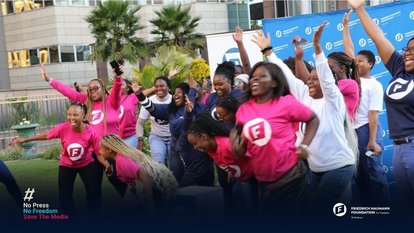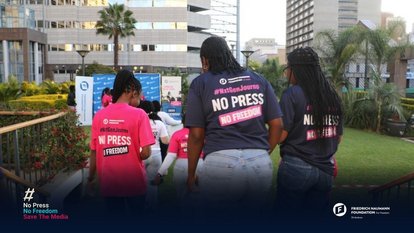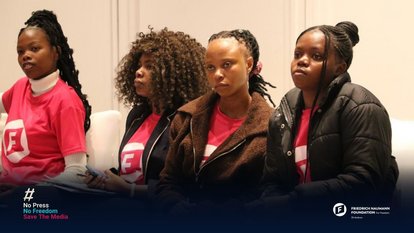Media
Womentorship reshapes Zimbabwean media

Journalist holding reporter microphone speaking and smiling to the camera for television news
© ShutterstockIn a world where newsrooms are still largely male-dominated and patriarchy continues to cast a long shadow over the media industry, a new generation of Zimbabwean female journalists is finding its voice—and its power—through the Womentorship Journalism Programme. Run by the Friedrich Naumann Foundation for Freedom (FNF), this transformative initiative is not only equipping young women with the tools they need to survive and thrive in journalism—it is helping to rewrite the rules of the game altogether. “The media remains male-dominated, and our society is still predominantly patriarchal,” said Fungisai Sithole, Programme Manager at FNF. “This in itself poses a challenge for young female entrants into the profession.”
Now in its fourth year, the Womentorship Journalism Programme has trained more than 450 aspiring female journalists, arming them with practical skills in photojournalism, fact-checking, business and financial reporting, political coverage, digital entrepreneurship, broadcasting, podcasting, multimedia production, and AI tools for modern journalism. “These sessions were all designed to build a well-rounded, credible, confident, and professional journalist with the capacity to transform newsrooms and the broader media landscape,” said Sithole.




The initiative forms part of FNF’s broader efforts to build open, equal, and democratic media environments where press freedom is actively promoted and defended. “This is a crucial intervention in a world that seeks to undermine media freedom, distort truth, and amplify fake news,” she added. The programme’s impact is already visible. According to Sithole, many alumni have received industry awards, started media startups, or significantly improved their journalistic output.
But Womentorship is also tackling the less visible—but no less dangerous—realities female journalists face. “Sexual harassment is a thorn in the flesh,” Sithole said. “It’s a matter of great concern, especially for young women on attachment in newsrooms.” She noted that continued mentorship, paired with increased male involvement in the programme, is helping change newsroom cultures from within. “We have begun introducing male experts into the programme as we seek to nurture an inclusive media where men are not seen as enemies but colleagues who can defend women’s rights in the media.” With resources stretched, the programme is choosing quality over quantity moving forward. “Due to funding constraints, we envisage improving on the quality, not just quantity,” Sithole said. “Smaller cohorts allow us to build stronger, more intimate networks and a formidable sisterhood in the media fraternity.”
For Tatenda Gabi, one of this year’s fellows, the Womentorship Programme was more than just a skills workshop—it was a safe space and a healing journey. “The fellowship equipped me with the skills I needed as a journalist. But it was more than journalism—it was a therapy session and a safe space,” she said.
Rukudzo Musari, another 2025 fellow, shared similar sentiments: “I learned that photojournalism can be a crucial part of investigative journalism. Beyond the technical skills, I gained valuable insights on the importance of confidence in my work and the need to reach out for support and guidance from peers.” She emphasized that journalism is no longer confined to the traditional newsroom. “This programme showed me that journalism can be a flexible and autonomous career path. We can leverage the internet and social media to create and share our own content, even without formal employment.” Crucially, she noted, collaboration is key. “Success in journalism often requires collaboration and support from others. Finding your sisters or network of peers who can offer advice, guidance, and encouragement can be crucial in navigating the newsroom and thriving in this field.” The roots of the Womentorship Programme lie in a stark reality: gender imbalance in Zimbabwean newsrooms remains deeply entrenched.
Faith Zaba, Editor of the Zimbabwe Independent and a mentor in the programme, knows the battle all too well. “We launched the Womentorship programme to challenge the deep-rooted gender imbalance in Zimbabwean newsrooms—long seen as a boys’ club,” Zaba said. “For women, journalism here is not just a job; it’s a constant fight against patriarchy, discrimination, and exclusion.” Her own rise through the ranks underscores the problem. “It took me 27 years to become an editor, and Victoria Ruzvidzo 25. That’s too long,” she said. “Womentorship is our response: a platform to empower young female journalists with the tools, confidence, and support to break into newsrooms, rise to leadership, and own their space in a shrinking, shifting media industry.” She said the programme doesn’t shy away from addressing the hard realities of the profession. “We cover real-world challenges: discrimination, bullying, safety, investigative reporting, covering the ‘hard beats,’ and adapting to a digital future.”
And this year, the programme expanded further—nurturing digital entrepreneurs among its fellows. “Women are building their own platforms, telling their stories, and creating income through digital tools,” Zaba said. “Because where old doors are closing, new ones are opening—and our mission is to ensure women walk boldly through them.” In a sector where women have historically been underrepresented, underpaid, and under-recognized, the Womentorship Journalism Programme is not just an intervention—it’s a movement. Its success lies not only in the technical training and career mentorship it offers, but in the solidarity and empowerment it fosters among women who are too often pushed to the margins.
Through sisterhood, skills-building, and a growing support network, Zimbabwe’s next generation of female journalists is pushing past patriarchal boundaries—and redefining what it means to be a woman in media. And with every story they tell, every newsroom they join, and every platform they launch, they are proving that the future of journalism isn’t just female—it’s fearless.
The original article is published on Business Times, Zimbabwe
